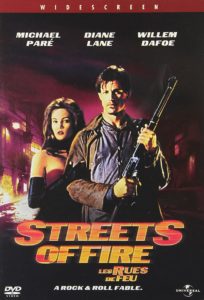Tropic Sprockets / Streets of Fire (1984)
By Ian Brockway
Walter Hill’s “Streets of Fire” is comic and kitschy, but its mixture of neon and grit speaks of the period. Its hybrid of danger and music illustrate the 1980s MTV generation but also underscore other films of the era from “Footloose” to “Road Warrior” given its hints of apocalypse. [Showtimes and trailer at Tropiccinema.com.]
It is an obvious comic book, but it is sincere in in its intent in being a popcorn film and its songs are catchy with a kind of Joan Jett sound.
Tom (Michael Pare) is a drifter with a heart. When superstar singer Ellen Aim (Diane Lane) gets kidnapped from her show by the hateful Raven (Willem Dafoe), nerdy boyfriend / manager Billy Fish (Rick Moranis) hires Tom for the rescue.
The episodes are preposterous and simplistic for certain, but the film succeeds as a time capsule of the video TV age. The score blends perfectly with the imagery which create a kind of Pop Art fusion of Paul Schrader and Roy Lichtenstein.
Pare is a Bruce Willis type, but his long coat is a nod to Dekker in “Blade Runner” two years before. He is the villain and despite this being a sort of rock musical, the actor is genuinely scary, a harbinger of Dennis Hopper. Raven walks though fire in one scene as an incarnation of the devil.
Amy Madigan is Pare’s tough sidekick, and she has the best lines.
The action is easy to ridicule but the film possesses a comfort in its very silliness and the allure of nostalgia is present.
The famous song “I Can Dream About You” is a danceable showstopper that speaks of all things neon with a definite beat. Other numbers carry the operatic fanfare of Meatloaf as they are written by songwriter Jim Steinman. Ry Cooder boosts the score further with blues and rockabilly interludes.
The film is intriguing because it is very much of its time. The retro 1950s cars combined with the dull cardboard city express all of the era, from Mad Max to John Carpenter’s “Escape From New York” (1981).
“Streets of Fire” was a lively counter to “Footlose” until Albert Magnoli and Prince supercharged the video opera into red and blue with “Purple Rain” that premiered a month later. David Lynch took the concept of a Luciferic villain in love with music in “Blue Velvet” two years later.
Though the cleverness of Lynch and Magnoli eclipsed the film’s ill-fated charm, the driving beats combined with Willem Dafoe’s unforgettable grimace (reminiscent of Klaus Kinski and Margaret Hamilton) still conjures a smile.
Write Ian at [email protected]
[livemarket market_name="KONK Life LiveMarket" limit=3 category=“” show_signup=0 show_more=0]
No Comment